Marine-Derived Streptomyces sennicomposti GMY01 with Anti-Plasmodial and Anticancer Activities: Genome Analysis, In Vitro Bioassay, Metabolite Profiling, and Molecular Docking
Abstract
1. Introduction
2. Materials and Methods
2.1. Biological Materials
2.2. Whole-Genome and Taxonogenomic Analysis
2.3. Cell Biomass Extraction
2.4. Antiplasmodial Assay
2.5. Anticancer Assay
2.6. Liquid Chromatography–Mass Spectrometry/Mass Spectrometry (LCMS/MS) Analysis
2.7. In Silico Molecular Docking
2.8. Ethical Clearance
3. Results
3.1. Whole-Genome and Taxogenomic Analysis
3.2. Anti-Plasmodial and Anticancer Activities
3.3. Main Constituent Profile and Predicted Galactose Metabolic Pathway
3.4. Molecular Docking
4. Discussion
5. Conclusions
6. Patents
Supplementary Materials
Author Contributions
Funding
Data Availability Statement
Acknowledgments
Conflicts of Interest
References
- Jagannathan, S.V.; Manemann, E.M.; Rowe, S.E.; Callender, M.C.; Soto, W. Marine Actinomycetes, New Sources of Biotechnological Products. Mar. Drugs 2021, 19, 365. [Google Scholar] [CrossRef]
- Vicente, J.; Stewart, A.; Song, B.; Hill, R.T.; Wright, J.L. Biodiversity of Actinomycetes Associated with Caribbean Sponges and Their Potential for Natural Product Discovery. Mar. Biotechnol. 2013, 15, 413–424. [Google Scholar] [CrossRef] [PubMed]
- Undabarrena, A.; Ugalde, J.A.; Seeger, M.; Cámara, B. Genomic Data Mining of the Marine Actinobacteria Streptomyces sp. H-KF8 Unveils Insights into Multi-Stress Related Genes and Metabolic Pathways Involved in Antimicrobial Synthesis. PeerJ 2017, 2017, e2912. [Google Scholar] [CrossRef] [PubMed]
- Weber, T.; Charusanti, P.; Musiol-Kroll, E.M.; Jiang, X.; Tong, Y.; Kim, H.U.; Lee, S.Y. Metabolic Engineering of Antibiotic Factories: New Tools for Antibiotic Production in Actinomycetes. Trends Biotechnol. 2015, 33, 15–26. [Google Scholar] [CrossRef]
- Dalisay, D.S.; Williams, D.E.; Wang, X.L.; Centko, R.; Chen, J.; Andersen, R.J. Marine Sediment-Derived Streptomyces Bacteria from British Columbia, Canada Are a Promising Microbiota Resource for the Discovery of Antimicrobial Natural Products. PLoS ONE 2013, 8, e77078. [Google Scholar] [CrossRef] [PubMed]
- Shaik, M.; Girija Sankar, G.; Iswarya, M.; Rajitha, P. Isolation and Characterization of Bioactive Metabolites Producing Marine Streptomyces Parvulus Strain Sankarensis-A10. J. Genet. Eng. Biotechnol. 2017, 15, 87–94. [Google Scholar] [CrossRef] [PubMed]
- Ramachandran, G.; Rajivgandhi, G.; Maruthupandy, M.; Manoharan, N. Extraction and Partial Purification of Secondary Metabolites from Endophytic Actinomycetes of Marine Green Algae Caulerpa Racemosa against Multi Drug Resistant Uropathogens. Biocatal. Agric. Biotechnol. 2019, 17, 750–757. [Google Scholar] [CrossRef]
- Rajan, B.M.; Kannabiran, K. Extraction and Identification of Antibacterial Secondary Metabolites from Marine Streptomyces sp. VITBRK2. Int. J. Mol. Cell. Med. 2014, 3, 130–137. [Google Scholar] [PubMed]
- Nguyen, H.T.; Pokhrel, A.R.; Nguyen, C.T.; Pham, V.T.T.; Dhakal, D.; Lim, H.N.; Jung, H.J.; Kim, T.S.; Yamaguchi, T.; Sohng, J.K. Streptomyces sp. VN1, a Producer of Diverse Metabolites Including Non-Natural Furan-Type Anticancer Compound. Sci. Rep. 2020, 10, 1756. [Google Scholar] [CrossRef]
- Dhaneesha, M.; Hasin, O.; Sivakumar, K.C.; Ravinesh, R.; Naman, C.B.; Carmeli, S.; Sajeevan, T.P. DNA Binding and Molecular Dynamic Studies of Polycyclic Tetramate Macrolactams (PTM) with Potential Anticancer Activity Isolated from a Sponge-Associated Streptomyces zhaozhouensis subsp. Mycale Subsp. Nov. Mar. Biotechnol. 2019, 21, 124–137. [Google Scholar] [CrossRef]
- Paulus, C.; Rebets, Y.; Tokovenko, B.; Nadmid, S.; Terekhova, L.P.; Myronovskyi, M.; Zotchev, S.B.; Rückert, C.; Braig, S.; Zahler, S.; et al. New Natural Products Identified by Combined Genomics-Metabolomics Profiling of Marine Streptomyces sp. MP131-18. Sci. Rep. 2017, 7, 42382. [Google Scholar] [CrossRef]
- Karthik, L.; Kumar, G.; Rao, K.V.B. Antioxidant Activity of Newly Discovered Lineage of Marine Actinobacteria. Asian Pac. J. Trop. Med. 2013, 6, 325–332. [Google Scholar] [CrossRef]
- Law, J.W.-F.; Chan, K.-G.; He, Y.-W.; Khan, T.M.; Mutalib, N.-S.A.; Goh, B.-H.; Lee, L.-H. Diversity of Streptomyces Spp. from Mangrove Forest of Sarawak (Malaysia) and Screening of Their Antioxidant and Cytotoxic Activities. Sci. Rep. 2019, 9, 15262. [Google Scholar] [CrossRef]
- Xu, X.N.; Chen, L.Y.; Chen, C.; Tang, Y.J.; Bai, F.W.; Su, C.; Zhao, X.Q. Genome Mining of the Marine Actinomycete Streptomyces sp. DUT11 and Discovery of Tunicamycins as Anti-Complement Agents. Front. Microbiol. 2018, 9, 1318. [Google Scholar] [CrossRef]
- Thiyagarajamoorthy, D.K.; Arulanandam, C.D.; Dahms, H.U.; Murugaiah, S.G.; Krishnan, M.; Rathinam, A.J. Marine Bacterial Compounds Evaluated by In Silico Studies as Antipsychotic Drugs Against Schizophrenia. Mar. Biotechnol. 2018, 20, 639–653. [Google Scholar] [CrossRef] [PubMed]
- Vega-Rodríguez, J.; Pastrana-Mena, R.; Crespo-Lladó, K.N.; Ortiz, J.; Ferrer-Rodríguez, I.; Serrano, A.E. Implications of Glutathione Levels in the Plasmodium Berghei Response to Chloroquine and Artemisinin. PLoS ONE 2015, 10, e0128212. [Google Scholar] [CrossRef] [PubMed][Green Version]
- Burrows, J.N.; Hooft Van Huijsduijnen, R.; Möhrle, J.J.; Oeuvray, C.; Wells, T.N. Designing the next Generation of Medicines for Malaria Control and Eradication. Malar. J. 2013, 12, 1–20. [Google Scholar] [CrossRef]
- Harinantenaina Rakotondraibe, L.; Rasolomampianina, R.; Park, H.Y.; Li, J.; Slebodnik, C.; Brodie, P.J.; Blasiak, L.C.; Hill, R.; Tendyke, K.; Shen, Y.; et al. Antiproliferative and Antiplasmodial Compounds from Selected Streptomyces Species. Bioorg. Med. Chem. Lett. 2015, 25, 5646–5649. [Google Scholar] [CrossRef]
- Das, A. Anticancer Effect of Antimalarial Artemisinin Compounds. Ann. Med. Health Sci. Res. 2015, 5, 93–102. [Google Scholar] [CrossRef]
- Tajuddeen, N.; Van Heerden, F.R. Antiplasmodial Natural Products: An Update. Malar. J. 2019, 18, 1–62. [Google Scholar] [CrossRef] [PubMed]
- Crespo-Ortiz, M.P.; Wei, M.Q. Antitumor Activity of Artemisinin and Its Derivatives: From a Well-Known Antimalarial Agent to a Potential Anticancer Drug. J. Biomed. Biotechnol. 2012, 2012, 247597. [Google Scholar] [CrossRef] [PubMed]
- Sumanadasa, S.D.M.; Goodman, C.D.; Lucke, A.J.; Skinner-Adams, T.; Saham, I.; Haque, A.; Do, T.A.; McFadden, G.I.; Fairlie, D.P.; Andrews, K.T. Antimalarial Activity of the Anticancer Histone Deacetylase Inhibitor SB939. Antimicrob. Agents Chemother. 2012, 56, 3849–3856. [Google Scholar] [CrossRef] [PubMed]
- Mikuni, K.; Nakanishi, K.; Hara, K.; Hara, K.; Iwatani, W.; Amano, T.; Nakamura, K.; Tsuchiya, Y.; Okumoto, H.; Mandai, T. In Vivo Antitumor Activity of Novel Water-Soluble Taxoids. Biol. Pharm. Bull. 2008, 31, 1155–1158. [Google Scholar] [CrossRef] [PubMed]
- Hartinger, C.; Nazarov, A.; Ashraf, S.; Dyson, P.; Keppler, B. Carbohydrate-Metal Complexes and Their Potential as Anticancer Agents. Curr. Med. Chem. 2008, 15, 2574–2591. [Google Scholar] [CrossRef]
- Xie, J.H.; Liu, X.; Shen, M.Y.; Nie, S.P.; Zhang, H.; Li, C.; Gong, D.M.; Xie, M.Y. Purification, Physicochemical Characterisation and Anticancer Activity of a Polysaccharide from Cyclocarya paliurus Leaves. Food Chem. 2013, 136, 1453–1460. [Google Scholar] [CrossRef]
- Jia, X.; Zhang, C.; Qiu, J.; Wang, L.; Bao, J.; Wang, K.; Zhang, Y.; Chen, M.; Wan, J.; Su, H.; et al. Purification, Structural Characterization and Anticancer Activity of the Novel Polysaccharides from Rhynchosia minima Root. Carbohydr. Polym. 2015, 132, 67–71. [Google Scholar] [CrossRef]
- Usoltseva, R.V.; Anastyuk, S.D.; Ishina, I.A.; Isakov, V.V.; Zvyagintseva, T.N.; Thinh, P.D.; Zadorozhny, P.A.; Dmitrenok, P.S.; Ermakova, S.P. Structural Characteristics and Anticancer Activity in Vitro of Fucoidan from Brown Alga Padina Boryana. Carbohydr. Polym. 2018, 184, 260–268. [Google Scholar] [CrossRef]
- Otoguro, K.; Ishiyama, A.; Kobayashi, M.; Sekiguchi, H.; Izuhara, T.; Sunazuka, T.; Tomoda, H.; Yamada, H.; Omura, S. In Vivo and in Vivo Antimalarial Activities of a Carbohydrate Antibiotic, Prumycin, against Drug-Resistant Strains of Plasmodia. J. Antibiot. 2004, 57, 400–402. [Google Scholar] [CrossRef][Green Version]
- Kinfe, H.H.; Moshapo, P.T.; Makolo, F.L.; Gammon, D.W.; Ehlers, M.; Schmuck, C. Preparation and Antimalarial Activity of a Novel Class of Carbohydrate-Derived, Fused Thiochromans. Eur. J. Med. Chem. 2014, 87, 197–202. [Google Scholar] [CrossRef]
- Madumo, G.K.; Moshapo, P.T.; Kinfe, H.H. Effects of Lipophilicity, Protecting Group and Stereochemistry on the Antimalarial Activity of Carbohydrate-Derived Thiochromans. Med. Chem. Res. 2018, 27, 817–833. [Google Scholar] [CrossRef]
- Farida, Y.; Widada, J.; Meiyanto, E. Combination Methods for Screening Marine Actinomycetes Producing Potential Compounds as Anticancer. Indones. J. Biotechnol. 2007, 12, 988–997. [Google Scholar] [CrossRef]
- Widada, J.; Damayanti, E.; Herdini, C.; Wijayanti, N.; Hosoyama, A.; Yamazoe, A.; Suzuki-Minakuchi, C.; Hariwiyanto, B.; Mubarika, S.; Dinoto, A.; et al. Draft Genome Sequence of the Marine-Derived, Anticancer Compound-Producing Bacterium Streptomyces Sp. Strain GMY01. Microbiol. Resour. Announc. 2023, 12, e01366-20. [Google Scholar] [CrossRef]
- Meier-Kolthoff, J.P.; Göker, M. TYGS Is an Automated High-Throughput Platform for State-of-the-Art Genome-Based Taxonomy. Nat. Commun. 2019, 10, 1–10. [Google Scholar] [CrossRef]
- Lefort, V.; Desper, R.; Gascuel, O. FastME 2.0: A Comprehensive, Accurate, and Fast Distance-Based Phylogeny Inference Program. Mol. Biol. Evol. 2015, 32, 2798–2800. [Google Scholar] [CrossRef] [PubMed]
- Farris, J.S. Estimating Phylogenetic Trees from Distance Matrices. Am. Nat. 1972, 106, 645–668. [Google Scholar] [CrossRef]
- Kreft, L.; Botzki, A.; Coppens, F.; Vandepoele, K.; Van Bel, M. PhyD3: A Phylogenetic Tree Viewer with Extended PhyloXML Support for Functional Genomics Data Visualization. Bioinformatics 2017, 33, 2946–2947. [Google Scholar] [CrossRef] [PubMed]
- Meier-Kolthoff, J.P.; Hahnke, R.L.; Petersen, J.; Scheuner, C.; Michael, V.; Fiebig, A.; Rohde, C.; Rohde, M.; Fartmann, B.; Goodwin, L.A.; et al. Complete Genome Sequence of DSM 30083T, the Type Strain (U5/41T) of Escherichia Coli, and a Proposal for Delineating Subspecies in Microbial Taxonomy. Stand. Genom. Sci. 2014, 9, 2. [Google Scholar] [CrossRef]
- Yoon, S.H.; Ha, S.M.; Kwon, S.; Lim, J.; Kim, Y.; Seo, H.; Chun, J. Introducing EzBioCloud: A Taxonomically United Database of 16S RRNA Gene Sequences and Whole-Genome Assemblies. Int. J. Syst. Evol. Microbiol. 2017, 67, 1613–1617. [Google Scholar] [CrossRef]
- Richter, M.; Rosselló-Móra, R.; Oliver Glöckner, F.; Peplies, J. JSpeciesWS: A Web Server for Prokaryotic Species Circumscription Based on Pairwise Genome Comparison. Bioinformatics 2016, 32, 929–931. [Google Scholar] [CrossRef]
- Richter, M.; Rosselló-Móra, R. Shifting the Genomic Gold Standard for the Prokaryotic Species Definition. Proc. Natl. Acad. Sci. USA 2009, 106, 19126–19131. [Google Scholar] [CrossRef]
- Aziz, R.K.; Bartels, D.; Best, A.; DeJongh, M.; Disz, T.; Edwards, R.A.; Formsma, K.; Gerdes, S.; Glass, E.M.; Kubal, M.; et al. The RAST Server: Rapid Annotations Using Subsystems Technology. BMC Genom. 2008, 9, 75. [Google Scholar] [CrossRef] [PubMed]
- Overbeek, R.; Olson, R.; Pusch, G.D.; Olsen, G.J.; Davis, J.J.; Disz, T.; Edwards, R.A.; Gerdes, S.; Parrello, B.; Shukla, M.; et al. The SEED and the Rapid Annotation of Microbial Genomes Using Subsystems Technology (RAST). Nucleic Acids Res. 2014, 42, D206–D214. [Google Scholar] [CrossRef] [PubMed]
- Blin, K.; Shaw, S.; Augustijn, H.E.; Reitz, Z.L.; Biermann, F.; Alanjary, M.; Fetter, A.; Terlouw, B.R.; Metcalf, W.W.; Helfrich, E.J.N.; et al. AntiSMASH 7.0: New and Improved Predictions for Detection, Regulation, Chemical Structures and Visualisation. Nucleic Acids Res. 2023, 51, 1–5. [Google Scholar] [CrossRef] [PubMed]
- Ghanem, N.B.; Sabry, S.A.; El-Sherif, Z.M.; Abu El-Ela, G.A. Isolation and Enumeration of Marine Actinomycetes from Seawater and Sediments in Alexandria. J. Gen. Appl. Microbiol. 2000, 46, 105–111. [Google Scholar] [CrossRef]
- Damayanti, E.; Widada, J.; Lotulung, P.D.N.; Dinoto, A.; Mustofa, M. Bioassay Guided Fractionation of Marine Streptomyces sp. GMY01 and Antiplasmodial Assay Using Microscopic and Flow Cytometry Method. Indones. J. Pharm. 2020, 31, 281–289. [Google Scholar] [CrossRef]
- Trager, W.; Jensen, J.B. Human Malaria Parasites in Continuous Culture. J. Parasitol. 2005, 91, 484–486. [Google Scholar] [CrossRef]
- Lambros, C.; Vanderberg, J.P. Synchronization of Plasmodium falciparum Erythrocytic Stages in Culture. J. Parasitol. 1979, 65, 418. [Google Scholar] [CrossRef]
- Hansen, M.B.; Nielsen, S.E.; Berg, K. Re-Examination and Further Development of a Precise and Rapid Dye Method for Measuring Cell Growth/Cell Kill. J. Immunol. Methods 1989, 119, 203–210. [Google Scholar] [CrossRef]
- Zhang, L.; Wang, J.; Li, T.; Li, P.; Wang, Y.; Yang, M.; Liu, J.; Liu, J. Determination of the Chemical Components and Phospholipids of Velvet Antler Using UPLC/QTOF-MS Coupled with UNIFI Software. Exp. Ther. Med. 2019, 17, 3789–3799. [Google Scholar] [CrossRef]
- Negi, A.; Bhandari, N.; Shyamlal, B.R.K.; Chaudhary, S. Inverse Docking Based Screening and Identification of Protein Targets for Cassiarin Alkaloids against Plasmodium falciparum. Saudi Pharm. J. 2018, 26, 546–567. [Google Scholar] [CrossRef]
- Sathishkumar, N.; Sathiyamoorthy, S.; Ramya, M.; Yang, D.U.; Lee, H.N.; Yang, D.C. Molecular Docking Studies of Anti-Apoptotic BCL-2, BCL-XL, and MCL-1 Proteins with Ginsenosides from Panax Ginseng. J. Enzyme Inhib. Med. Chem. 2012, 27, 685–692. [Google Scholar] [CrossRef]
- Yun, C.W.; Lee, S.H. The Roles of Autophagy in Cancer. Int. J. Mol. Sci. 2018, 19, 3466. [Google Scholar] [CrossRef] [PubMed]
- Trott, oleg; Olson, A.J. AutoDock Vina: Improving the Speed and Accuracy of Docking with a New Scoring Function, Efficient Optimization, and Multithreading. J. Comput. Chem. 2010, 31, 671–690. [Google Scholar] [CrossRef]
- Studio, D. Dassault Systemes BIOVIA, Discovery Studio Modelling Environment, Release 4.5; Accelrys Software Inc.: San Diego, CA, USA, 2015. [Google Scholar]
- Damayanti, E.M.A.; Lisdiyanti, P.; Sundowo, A.; Ratnakomala, S. Antiplasmodial Activity, Biosynthetic Gene Clusters Diversity, and Secondary Metabolite Constituent of Selected Indonesian Streptomyces. Biodivers. J. Biol. Divers. 2021, 22, 3478–3487. [Google Scholar] [CrossRef]
- Duangupama, T.; Pittayakhajonwut, P.; Intaraudom, C.; Suriyachadkun, C.; Sirirote, P.; He, Y.W.; Thawai, C. Streptomyces sennicomposti Sp. Nov., an Actinomycete Isolated from Compost of Senna siamea (Lam.). Int. J. Syst. Evol. Microbiol. 2022, 72, 005320. [Google Scholar] [CrossRef]
- Yoon, S.H.; Ha, S.M.; Lim, J.; Kwon, S.; Chun, J. A Large-Scale Evaluation of Algorithms to Calculate Average Nucleotide Identity. Antonie van Leeuwenhoek Int. J. Gen. Mol. Microbiol. 2017, 110, 1281–1286. [Google Scholar] [CrossRef]
- Sakuda, S.; Ze-Zhou, Y.; Yamada, Y. Structure of a Novel Disulfide of 2-(N-Acetylcysteinyl)Amido-2-Deoxy-a-d-Glucopyran-Osyl-Fftyo-Inositol Produced by Streptomyces sp. Biosci. Biotechnol. Biochem. 1994, 58, 1347–1348. [Google Scholar] [CrossRef]
- Fujiwara, T.; Takahashi, Y.; Matsumoto, K.; Kondo, E. Production of a New Aminoglycoside Antibiotic by a Mutant of Bacillus Circulans. J. Antibiot. 1980, 33, 836–841. [Google Scholar] [CrossRef]
- Zhang, R.; Li, X.Y.; Cen, X.L.; Gao, Q.H.; Zhang, M.; Li, K.Y.; Wu, Q.; Mu, Y.L.; Tang, X.H.; Zhou, J.P.; et al. Enzymatic Preparation of Manno-Oligosaccharides from Locust Bean Gum and Palm Kernel Cake, and Investigations into Its Prebiotic Activity. Electron. J. Biotechnol. 2021, 49, 64–71. [Google Scholar] [CrossRef]
- Safitri, A.H.; Yopi; Meryandini, A. Enzymatic Hydrolysis of Porang by Streptomyces Violascens BF 3.10 Mannanase for the Production of Mannooligosaccharides. Media Peternak. 2014, 37, 190–197. [Google Scholar] [CrossRef][Green Version]
- Jana, U.K.; Suryawanshi, R.K.; Prajapati, B.P.; Kango, N. Prebiotic Mannooligosaccharides: Synthesis, Characterization and Bioactive Properties. Food Chem. 2021, 342, 128328. [Google Scholar] [CrossRef]
- Ghosh, A.; Verma, A.K.; Tingirikari, J.R.; Shukla, R.; Goyal, A. Recovery and Purification of Oligosaccharides from Copra Meal by Recombinant Endo-β-Mannanase and Deciphering Molecular Mechanism Involved and Its Role as Potent Therapeutic Agent. Mol. Biotechnol. 2015, 57, 111–127. [Google Scholar] [CrossRef]
- Ale, M.T.; Mikkelsen, J.D.; Meyer, A.S. Important Determinants for Fucoidan Bioactivity: A Critical Review of Structure-Function Relations and Extraction Methods for Fucose-Containing Sulfated Polysaccharides from Brown Seaweeds. Mar. Drugs 2011, 9, 2106–2130. [Google Scholar] [CrossRef]
- Müller, S. Role and Regulation of Glutathione Metabolism in Plasmodium falciparum. Molecules 2015, 20, 10511–10534. [Google Scholar] [CrossRef] [PubMed]
- GÜLLER, P. The In Vitro and In Silico Inhibition Mechanism of Glutathione Reductase by Resorcinol Derivatives: A Molecular Docking Study. J. Mol. Struct. 2021, 1228, 129790. [Google Scholar] [CrossRef]
- Adams, Y.; Olsen, R.W.; Bengtsson, A.; Dalgaard, N.; Zdioruk, M.; Satpathi, S.; Behera, P.K.; Sahu, P.K.; Lawler, S.E.; Qvortrup, K.; et al. Plasmodium falciparum Erythrocyte Membrane Protein 1 Variants Induce Cell Swelling and Disrupt the Blood-Brain Barrier in Cerebral Malaria. J. Exp. Med. 2021, 218, e20201266. [Google Scholar] [CrossRef] [PubMed]
- Penna-Coutinho, J.; Cortopassi, W.A.; Oliveira, A.A.; França, T.C.C.; Krettli, A.U. Antimalarial Activity of Potential Inhibitors of Plasmodium falciparum Lactate Dehydrogenase Enzyme Selected by Docking Studies. PLoS ONE 2011, 6, e21237. [Google Scholar] [CrossRef]
- Damayanti, E.; Nisa, K.; Handayani, S.; Dewi, R.T.; Febriansah, R.; Mustofa; Dinoto, A.; Widada, J. Cytotoxicity and Molecular Mechanism of Marine-Derived Streptomyces sp. GMY01 on Human Lung Cancer Cell Line A549. J. Appl. Pharm. Sci. 2020, 11, 46–55. [Google Scholar] [CrossRef]
- Chawsheen, M.A.; Dash, P.R. MTOR Modulates Resistance to Gemcitabine in Lung Cancer in an MTORC2 Dependent Mechanism. Cell. Signal. 2021, 81, 109934. [Google Scholar] [CrossRef]
- Chaube, U.J.; Rawal, R.; Jha, A.B.; Variya, B.; Bhatt, H.G. Design and Development of Tetrahydro-Quinoline Derivatives as Dual MTOR-C1/C2 Inhibitors for the Treatment of Lung Cancer. Bioorg. Chem. 2021, 106, 104501. [Google Scholar] [CrossRef]
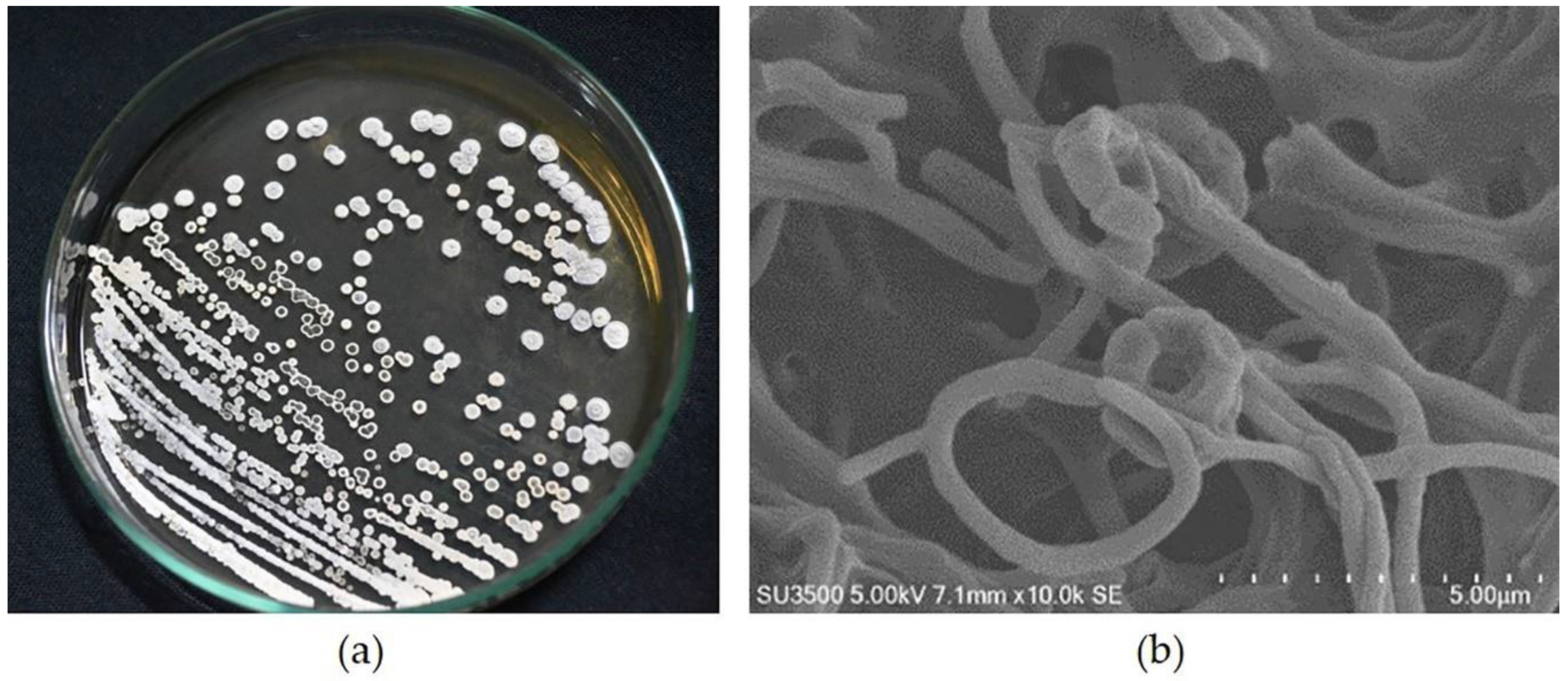
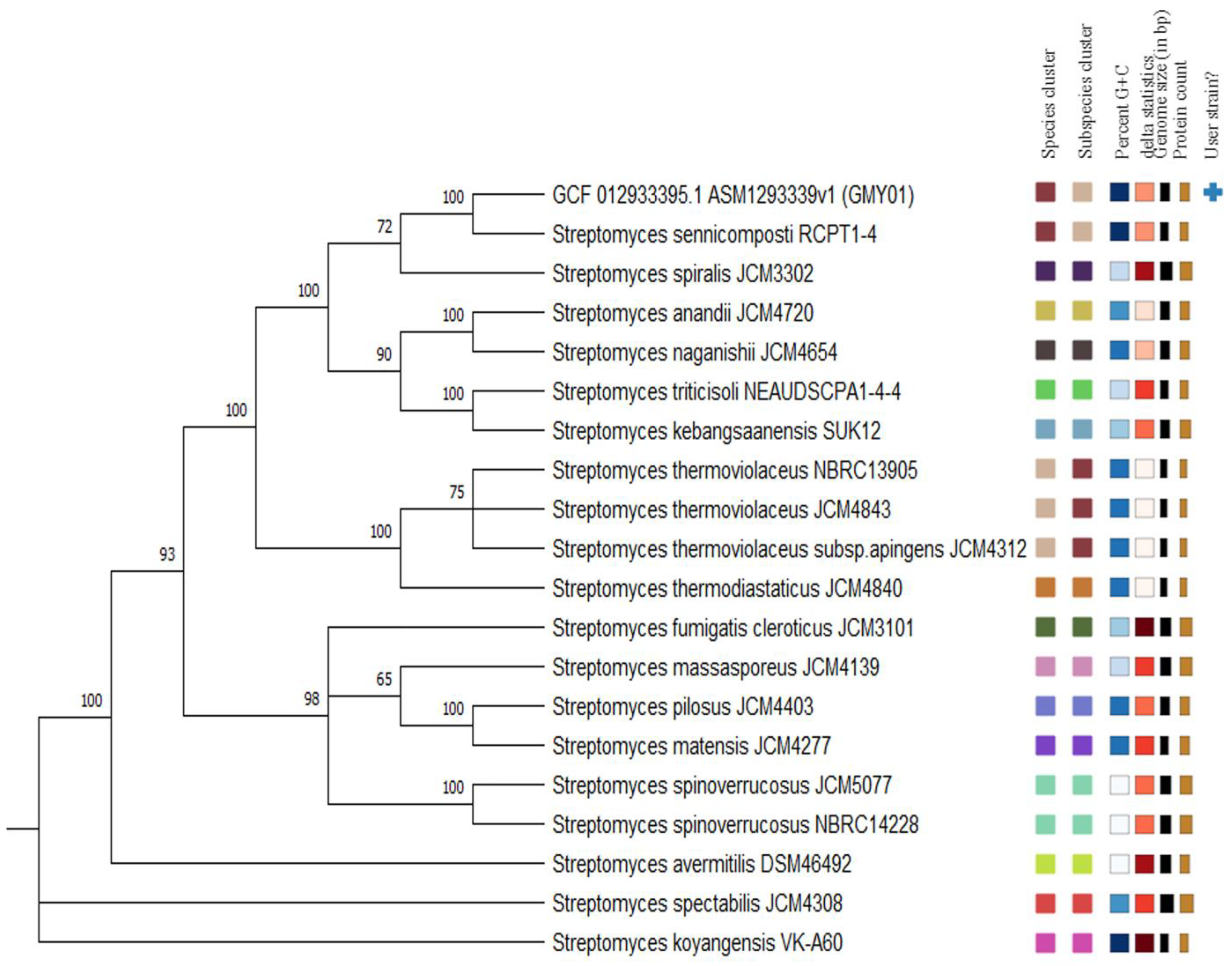
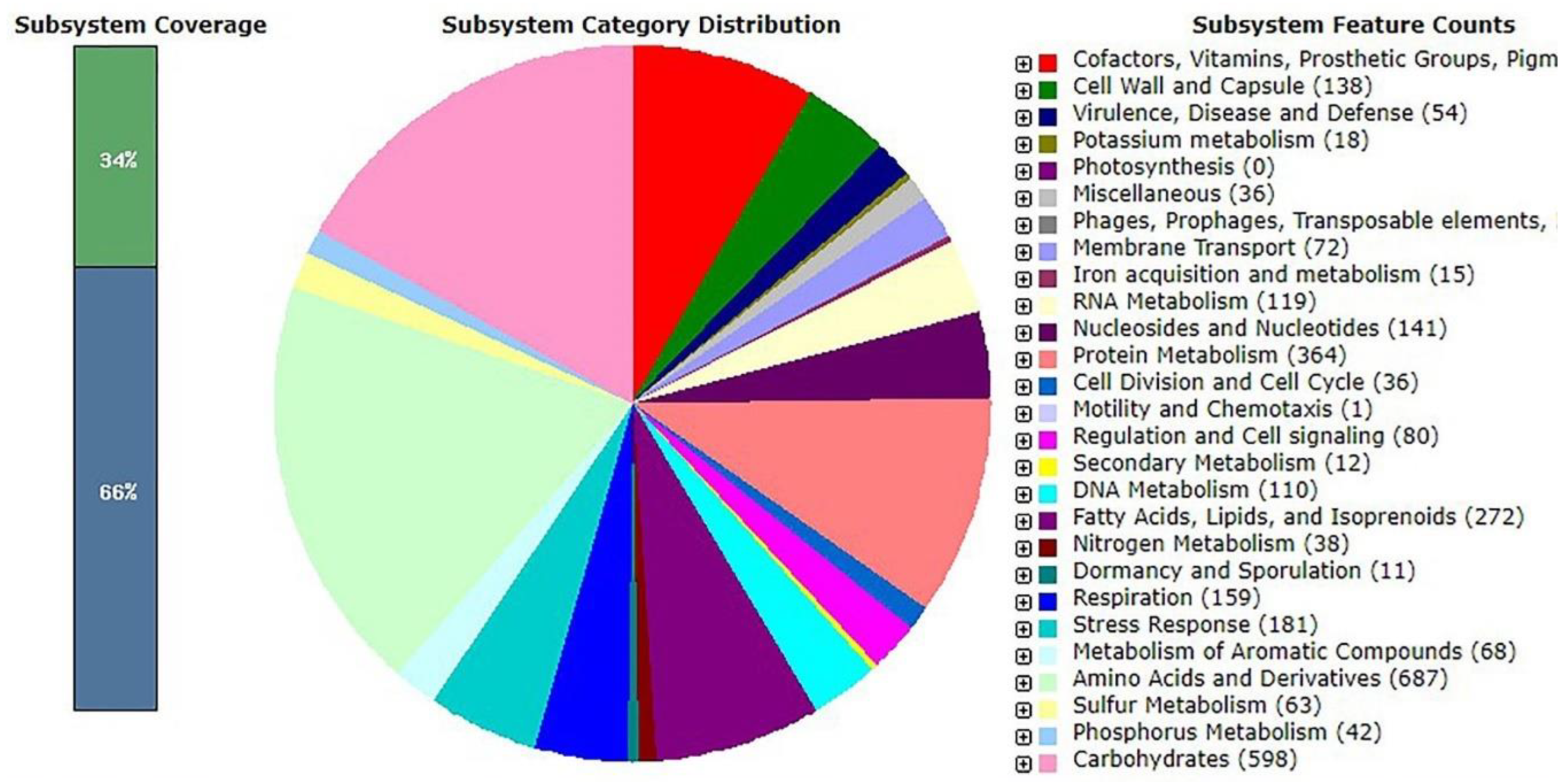
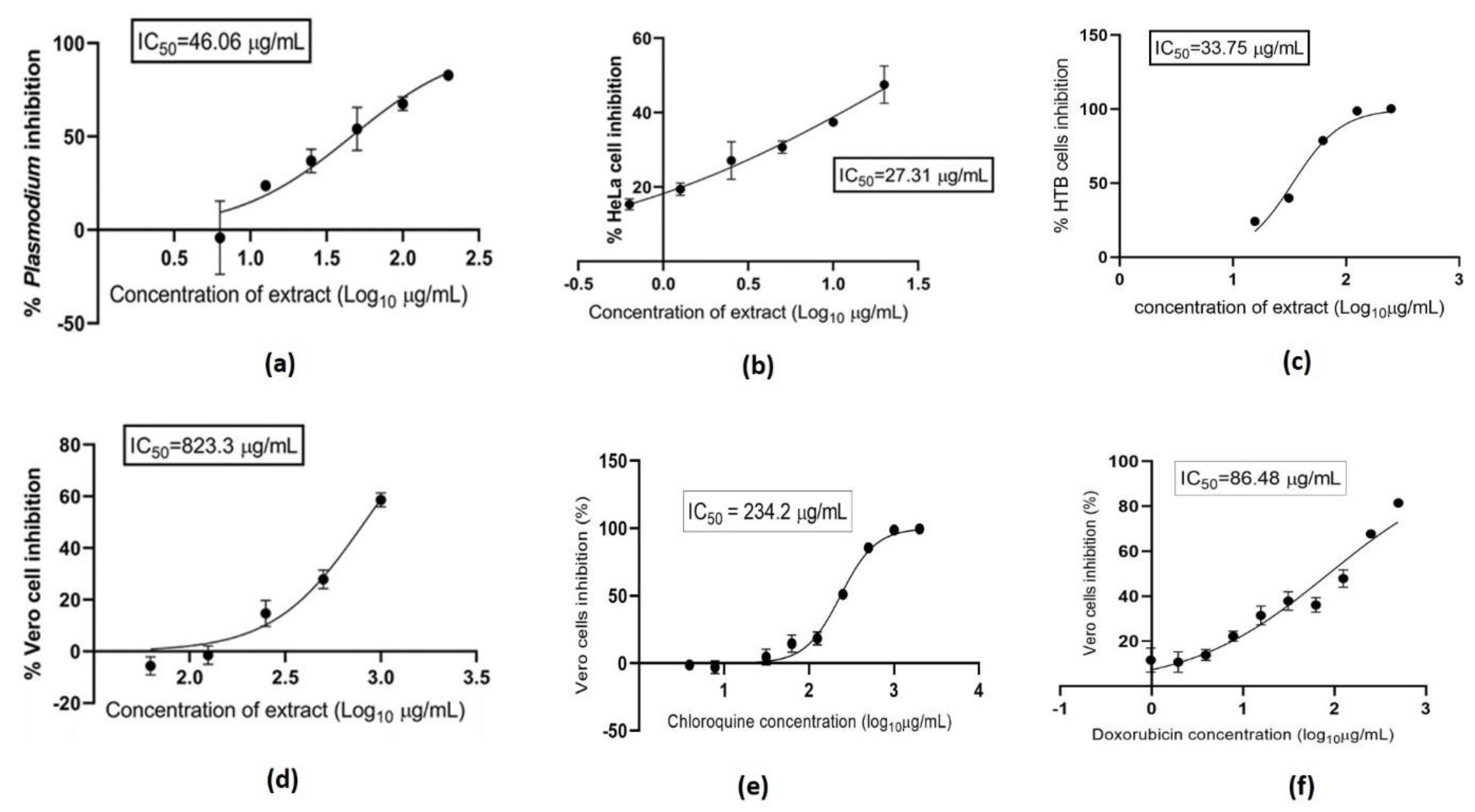
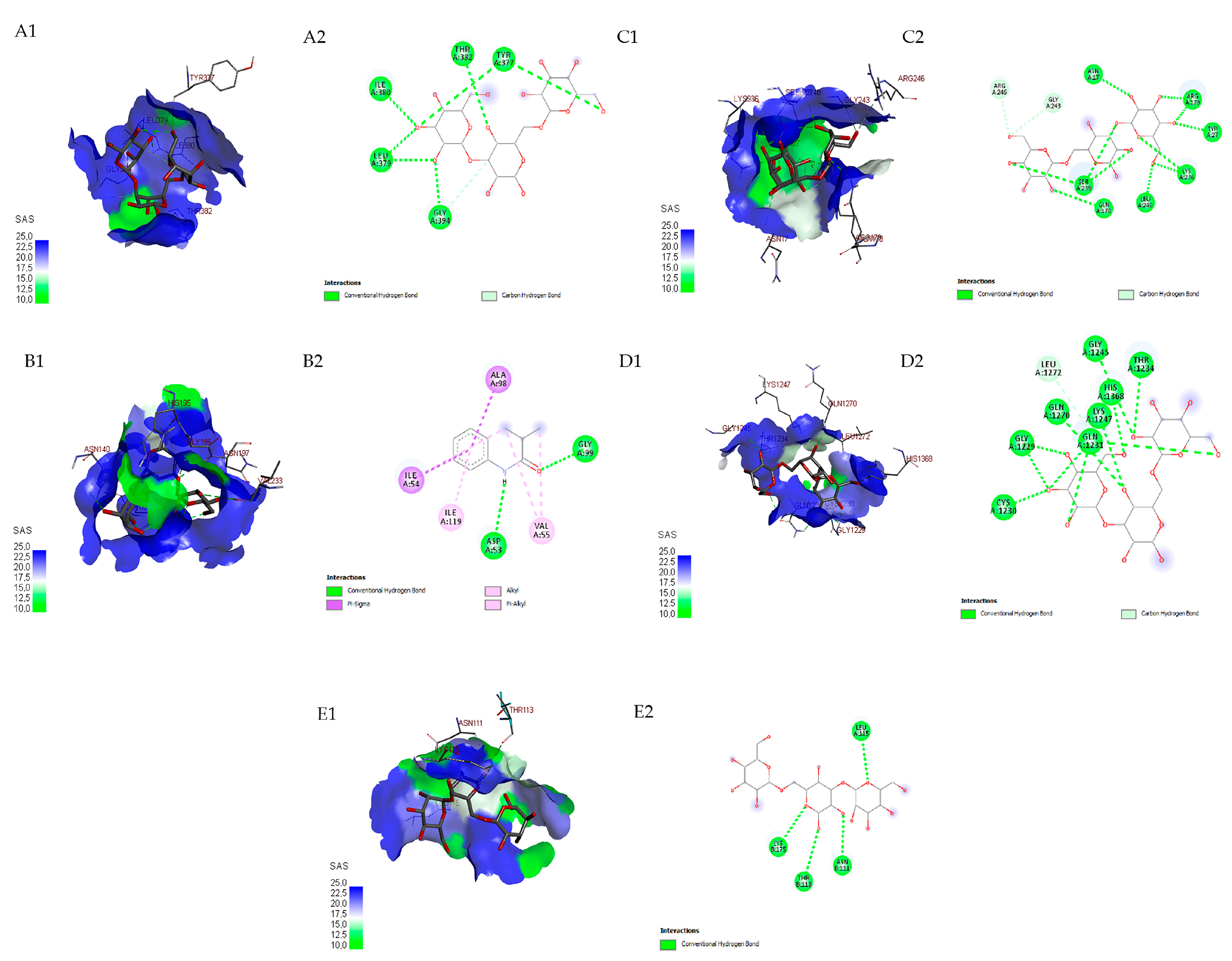
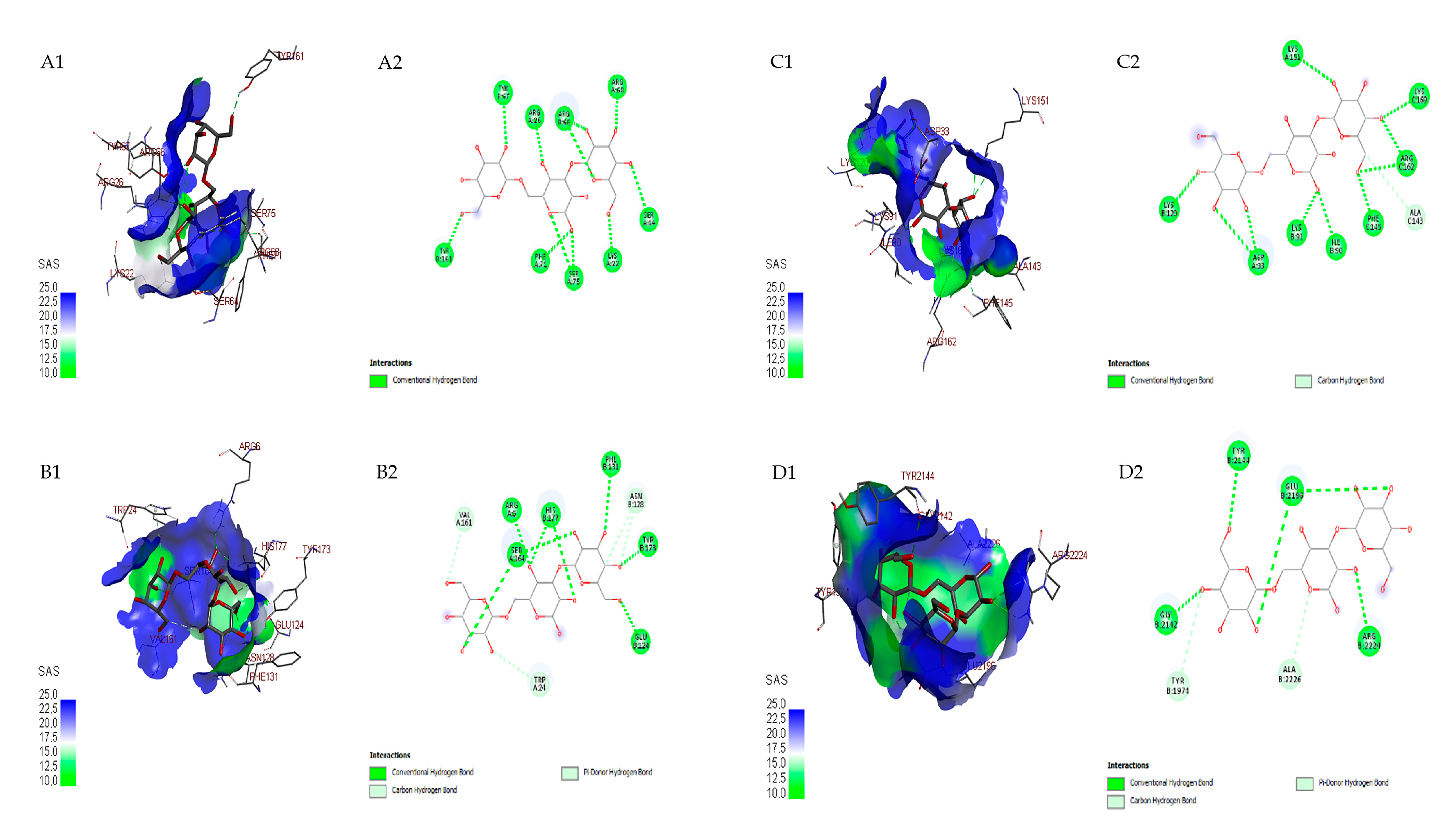
| References | Size | Contigs | GC (%) | Ortho ANIu 1 | Average Aligned Length (bp) | ANIb 2 | Aligned (%) | z-Score 3 |
|---|---|---|---|---|---|---|---|---|
| S. sennicomposti RCPT1-4T | 7,351,330 | 150 | 73.09 | 98.09 | 4,709,881 | 97.33 | 70.86 | 0.99978 |
| S. spiralis JCM 3302 | 9,813,663 | 176 | 71.26 | 86.15 | 3,378,116 | 85.75 | 50.63 | 0.98819 |
| S. kebangsaanensis SUK12 | 8,244,886 | 170 | 71.57 | 85.61 | 2,923,156 | 84.66 | 44.98 | 0.98559 |
| S. naganishii JCM 4654 | 7,809,671 | 76 | 72.61 | 85.73 | 3,120,830 | 85.02 | 48.11 | 0.98964 |
| Region | Type | Most Similar Known Cluster | Similarity (%) |
|---|---|---|---|
| 1.1 | T3PKS | Flaviolin, polyketide | 100 |
| 1.2 | NRPS, NAPAA | Stenothricin, NRP:cyclic depsipeptide | 13 |
| 3.1 | NI-siderophore | Grincamycin, polyketide type II | 5 |
| 4.1 | Terpene | Geosmin, terpene | 100 |
| 4.2 | NRP-metallophore, NRPS | Griseobactin, NRP | 61 |
| 4.3 | T1PKS, NRPS like, NRPS, butyrolactone, LAP | Microansamycin, Polyketide | 66 |
| 4.4 | NI-siderophore | ||
| 6.1 | T2PKSs | Spore pigment, polyketide | 83 |
| 16.1 | Terpene | Isorenieratene, terpene | 75 |
| 17.1 | Lanthipeptide-class-iv | Venezuelin, RiPP:Lanthipeptide | 50 |
| 17.2 | RiPP-like | ||
| 17.3 | NRPS, other, NRPS-like | S56-p1, NRP | 17 |
| 18.1 | Terpene | Albaflavenone | 100 |
| 19.1 | Butyrolactone | Gaburedin A-F, other | 70 |
| 26.1 | hgIE-KS, T1PKS | Vazabitide A, NRP | 17 |
| 26.2 | RiPP-like, lanthipeptide-class-iii | Informatipeptin, RiPP-lanthipeptide | 100 |
| 28.1 | Ectoin | Ectoin, other | 100 |
| 34.1 | NRP- metallophore, NRPS | Mirubactin, NRPS | 50 |
| 36.1 | NRP-metallophore, T1PKS, NRPS | Scabichelin, NRP | 90 |
| 38.1 | NRPS-like, NRPS | Antipain, NRP | 100 |
| 39.1 | NRPS | Saframycin A/B, NRP | 12 |
| 47.1 | NRPS, lanthipeptide-class-ii | Lysocin, NRP | 9 |
| 48.1 | Terpene | Hopene, terpene | 61 |
| 53.1 | Lanthipeptide-class-iv | Class IV lanthipeptide/SflA, RiPP | 100 |
| 56.1 | Butyrolactone | ||
| 57.1 | T1PKSA | Abyssomicin M-X, polyketide | 56 |
| 63.1 | NRPS | Saframycin A/B, NRP | 12 |
| 65.1 | NRPS-like | Saframycin Mx1, NRP | 66 |
| Observed RT (min) | Compound | Observed m/z | Neutral Mass (Da) | Relative Abundance (% Area) |
|---|---|---|---|---|
| 1.06 | C18H32O16 | 527.1579 | 504.16903 | 1.96 |
| 1.08 | C17H29NO14 | 472.1660 | 471.15880 | 97.50 |
| 1.64 | C19H31NO13 | 482.1864 | 481.17954 | 0.54 |
| Compound | Target Proteins | Affinity | RMSD | Binds to Amino Acids | |
|---|---|---|---|---|---|
| Lower Bond | Upper Bond | ||||
| Mannotriose | GR (1ONF) | −7.3 | 1.834 | 2.645 | Ile (380), Leu (379), Gly (394), Thr (382), Tyr (377) |
| LDH (1CET) | −7.3 | 1.486 | 5.080 | Val (233), Arg (109), Asn (140), His (195), Asn (197), Gly (196) | |
| PMT (4FGZ) | −7.7 | 1.834 | 6.370 | Arg (246), Gly (243), Asn (17), Arg (179), Tyr (27), Lys (236), Leu (240), Ser (239), Gln (178) | |
| EMP1 (3CPZ) | −7.6 | 1.968 | 6.492 | Leu (1272), Gly (1245), Thr (1234), His (1368), Lys (1247), Gln (1231), Gln (1270), Gly (1229), Cys (1230) | |
| GST (4ZXG) | −6.4 | 1.763 | 3.665 | Leu (115), Asn (111), Thr (113), Lys (175) | |
| N-acetylneuraminyl-(2-6)-galactose | GR (1ONF) | −6.7 | 1.961 | 3.964 | Gly (394), Ile (380), Leu (379), Lys (213), Gln (351) |
| LDH (1CET) | −6.6 | 1.577 | 2.613 | Arg (109), Leu (237), Arg (171), Thr (232), Asp (168), Val (233), His (195), Val (138), Gly (196) | |
| PMT (4FGZ) | −6.5 | 1.933 | 3.334 | Arg (179), Asp (242), Gln (178), Lys (236), Ser (239) | |
| EMP1 (3CPZ) | −6.4 | 1.770 | 4.672 | Cys (1273), Cys (1230), Gln (1231), Arg (1228), Ile (1227), His (1368), Thr (1234), Gln (1270), Tyr (1366), Lys (1247), Asn (1271) | |
| GST (4ZXG) | −6.1 | 1.067 | 2.008 | Lys (175), Phe (110) | |
| Chloroquine * | GR (1ONF) | −5.1 | 1.762 | 2.566 | Ala (480), Ala (472), Met (470), Ala (488), Ile (483), Thr (480) |
| LDH (1CET) | −5.0 | 1.936 | 2.792 | Val (233), Leu (201), Glu (310) | |
| PMT (4FGZ) | −4.9 | 1.891 | 2.856 | Glu (28), Lys (177), Lys (25) | |
| EMP1 (3CPZ) | −5.4 | 1.917 | 2.932 | Phe (1553), Tyr (1565), Ile (1512), Lys (1516) | |
| GST (4ZXG) | −5.5 | 1.884 | 2.547 | Lys (46), Leu (180), Pro (177), Phe (183), Leu (180) | |
| Doxorubicin ** | GR (1ONF) | −7.8 | 1.684 | 2.170 | Ala (399), Ser (396), Lys (213), Thr (392), Gly (394), Thr (382), Ile (380), Phe (214), Tyr (185) |
| LDH (1CET) | −7.5 | 1.928 | 5.934 | Ile (31), Ser (245), Pro (246) | |
| PMT (4FGZ) | −9.5 | 1.622 | 2.018 | Asp (250), Arg (246), Asp (242), Tyr (175), Gly (243), Arg (179), Arg (97) | |
| EMP1 (3CPZ) | −7.4 | 1.810 | 2.307 | His (1368), Val (1274), Gln (1231), Gly (1229), Cys (1230), Lys (1247) | |
| GST (4ZXG) | −7.4 | 1.656 | 2.103 | Lys (175), Lys (110), Phe (110) | |
| Compound | Target Proteins | Affinity | RMSD | Binds to Amino Acids | |
|---|---|---|---|---|---|
| Lower Bond | Upper Bond | ||||
| Mannotriose | BCL-2 (2w3l) | −8.4 | 1.878 | 5.304 | Tyr (67), Tyr (161), Arg (26), Arg (66), Arg (68), Ser (64), Lys (22), Ser (75), Phe (71) |
| BCL XL (2yxj) | −7.4 | 1.891 | 5.662 | Val (161), Arg (6), His (177), Ser (164), Phe (131), Asn (128), Tyr (173), Glu (124), Trp (24) | |
| mTORC1 (6BT0) | −8.0 | 0.965 | 2.103 | Lys (120), Asp (33), Lys (91), Ile (90), Phe (145), Ala (143), Arg (162), Lys (169), Lys (151) | |
| mTORC2 (6zwo) | −8.3 | 1.691 | 2.599 | Tyr (2144), Gly (2142), Tyr (1974), Ala (2226), Arg (2224), Glu (2196) | |
| N-acetylneuraminyl-(2-6)-galactose | BCL-2 (2w3l) | −7.4 | 1.297 | 1.871 | Asn (122), Arg (26), Lys (22), Ser (64), Arg (66), Arg (68), Arg (65), Ser (75), Phe (71) |
| BCL XL (2yxj) | −6.3 | 1.962 | 6.445 | Arg (6), Asn (128), Tyr (173), His (177), Ser (164) | |
| mTORC1 (6BT0) | −8.0 | 1.845 | 2.552 | Ser (16), Tyr (35), Ser (34), Ser (20), Lys (19), Ser (21) | |
| mTORC2 (6zwo) | −7.2 | 1.929 | 2.840 | Asp (594), Arg (363), Tyr (490), Leu (364), Trp (362), Ser (491), Gln (657), Leu (492), His (658), Lys (599) | |
| Chloroquine * | BCL-2 (2w3l) | −5.8 | 1.904 | 5.152 | Phy (71), Tyr (67), Met (74), Leu (96), Phe (63), Arg (105), Ala (108) |
| BCL XL (2yxj) | −6.4 | 1.449 | 2.091 | Ala (71), Phe (49), Phe (259), Leu (12), Asp (211), Asp (123) | |
| mTORC1 (6BT0) | −6.1 | 1.179 | 2.005 | Ala (150), Lys (120), Phe (31), Asp (33), Pro (37) | |
| mTORC2 (6zwo) | −6.4 | 1.342 | 2.118 | Ala (47), Cys (133), Ser (90), Thr (2279), Ala (89), Trp (274) | |
| Doxorubicin ** | BCL-2 (2w3l) | −10.1 | 1.429 | 2.034 | Arg (68), Asp (61), Ser (64), Phe (71), Ser (75), Arg (66), Phe (63), Val (107) |
| BCL XL (2yxj) | −7.2 | 1.474 | 2.413 | Asn (136), Arg (139), Ala (142), Phe (97), Leu (130), Ala (104), Leu (108), Glu (129) | |
| mTORC1 (6BT0) | −9.2 | 1.577 | 2.214 | Gly (29), Asp (33), Phe (31), Glu (139), Lys (135), Lys (91), Tyr (131) | |
| mTORC2 (6zwo) | −8.2 | 1.857 | 2.618 | Glu (2190), Asp (2357), Ser (2165), Lys (2187), Ile (2537), Ile (2356), Try (2239), Thr (2245) | |
Disclaimer/Publisher’s Note: The statements, opinions and data contained in all publications are solely those of the individual author(s) and contributor(s) and not of MDPI and/or the editor(s). MDPI and/or the editor(s) disclaim responsibility for any injury to people or property resulting from any ideas, methods, instructions or products referred to in the content. |
© 2023 by the authors. Licensee MDPI, Basel, Switzerland. This article is an open access article distributed under the terms and conditions of the Creative Commons Attribution (CC BY) license (https://creativecommons.org/licenses/by/4.0/).
Share and Cite
Widada, J.; Damayanti, E.; Mustofa, M.; Dinoto, A.; Febriansah, R.; Hertiani, T. Marine-Derived Streptomyces sennicomposti GMY01 with Anti-Plasmodial and Anticancer Activities: Genome Analysis, In Vitro Bioassay, Metabolite Profiling, and Molecular Docking. Microorganisms 2023, 11, 1930. https://doi.org/10.3390/microorganisms11081930
Widada J, Damayanti E, Mustofa M, Dinoto A, Febriansah R, Hertiani T. Marine-Derived Streptomyces sennicomposti GMY01 with Anti-Plasmodial and Anticancer Activities: Genome Analysis, In Vitro Bioassay, Metabolite Profiling, and Molecular Docking. Microorganisms. 2023; 11(8):1930. https://doi.org/10.3390/microorganisms11081930
Chicago/Turabian StyleWidada, Jaka, Ema Damayanti, Mustofa Mustofa, Achmad Dinoto, Rifki Febriansah, and Triana Hertiani. 2023. "Marine-Derived Streptomyces sennicomposti GMY01 with Anti-Plasmodial and Anticancer Activities: Genome Analysis, In Vitro Bioassay, Metabolite Profiling, and Molecular Docking" Microorganisms 11, no. 8: 1930. https://doi.org/10.3390/microorganisms11081930
APA StyleWidada, J., Damayanti, E., Mustofa, M., Dinoto, A., Febriansah, R., & Hertiani, T. (2023). Marine-Derived Streptomyces sennicomposti GMY01 with Anti-Plasmodial and Anticancer Activities: Genome Analysis, In Vitro Bioassay, Metabolite Profiling, and Molecular Docking. Microorganisms, 11(8), 1930. https://doi.org/10.3390/microorganisms11081930






